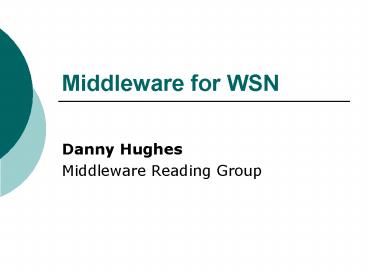Middleware for WSN - PowerPoint PPT Presentation
1 / 26
Title:
Middleware for WSN
Description:
COUGAR: Represents all sensors and sensor data in a relational database. ... COUGAR. IMPALA. MAGNET. MATE. How Would GridKit Do? Write my next related work section: ... – PowerPoint PPT presentation
Number of Views:190
Avg rating:3.0/5.0
Title: Middleware for WSN
1
Middleware for WSN
- Danny Hughes
- Middleware Reading Group
2
Introduction
- Discussing the paper Geoff mentioned Middleware
Challenges and Approaches for Wireless Sensor
Networks - Discusses and evaluates a range of middleware for
WSN (in a somewhat superficial way). - How would GridKit fair in this evaluation?
3
Applications of WSN
- Military
- Environmental Monitoring
- Industrial Processes
- Transportation
- Smart objects/homes/offices
4
Challenges for Middleware in WSN
- Power Constraints
- Must run for long periods.
- Potentially variable power supply (e.g. Solar).
- Demands file-grained control of CPU, network and
activation of on-board devices. - Heterogeneity
- CPU-power Original PC (8088) to
Pentium-equivalent. - Networking Zigbee 802.11x.
- Memory and Storage
- Operating Systems Tiny OS Linux.
5
Challenges for Middleware in WSN
- Why Ad-Hoc Networking?
- Client/Server approach impossible.
- Infrastructure often unavailable.
- Ad-Hoc Networking Challenges
- Node failure.
- Heterogeneous capabilities.
- Variable resource availability.
- Resource discovery.
- Security.
6
Challenges for Middleware in WSN
- Requirements from the application-domains
- Real-time nature of monitoring.
- Need to adapt to changing conditions.
- Trade-off between application specificity and
generality. - Long-term, autonomous operation.
- Scalability.
7
Classification Scheme
8
Classification Scheme
Conceptual models.
9
Classification Scheme
Systems, services and run-time mechanisms.
10
Virtual Machines
- Benefits
- Common abstraction
- Sand-boxing
- Distribution of code
- Drawbacks
- High overhead
- Difficult to exploit heterogeneity
11
Virtual Machine Approaches
- MATE
- Power-centric abstraction.
- Tied to TinyOS.
- MATE programs are broken up into small capsules.
- Capsules form a unit of distribution.
- Communication in synchronous.
- No support for message buffering / large storage.
12
Virtual Machine Approaches
- MAGNET
- Power-aware, adaptive OS.
- The whole network appears as a single JVM.
- Standard Java programs are re-written by MAGNET
as network components. - Components may then be injected into the
network using a power-optimized scheme.
13
Virtual Machine Approaches
- Critique
- Targeted at highly embedded nodes.
- Assumes sensors are dumb.
- Very simple, fixed network abstraction.
- Impossible to exploit heterogeneity.
- Power is important, but is it always critical.
14
Mobile Agents
- Benefits
- Code updates propagate efficiently as only parts
of the program need be updated. - Potential for dynamic evolution of programs.
- Drawbacks
- High overhead, unsuitable for highly embedded
devices.
15
Mobile Agent Approaches
- IMPALA
- Focus is on efficiency of updates, to support
dynamic applications. - Efficient updates are achieved at the expense of
heterogeneity (updates are compiled to binary
units). - Different profiles possible (not just energy
efficiency).
16
Mobile Agent Approaches
- Critique
- Allows more scope for node autonomy than
virtual-machine approaches. - Tied to a single hardware platform.
- Does not deal with networking issues outside of
code updates.
17
Databases
- Benefits
- Entire sensor network is abstracted as a virtual
relational database. - Very easy to interoperate with existing systems.
- Drawbacks
- Not real time.
- Does not allow steering of sensing.
18
Database Approaches
- COUGAR
- Represents all sensors and sensor data in a
relational database. - Control of sensors and extracting data occurs
through special SQL-like queries. - Allows the scheduling of ongoing queries that
provide incremental results. - Decetralized Implementation, message passing
based on controlled flooding.
19
Database Approaches
- SINA
- Based on a spreadsheet database, wherein network
is a collection of data-sheets and cells are
attributes. - Queries again performed in an SQL-like language.
- Decentralised Implementation based on clustering.
20
Database Approaches
- Critique
- Allow for very little node autonomy.
- Impossible to exploit heterogeneity.
- Does not tie in well with monitoring which is
largely event-driven.
21
Message-oriented Middleware
- Benefits
- Publish-subscribe communications model.
- Allows direct communication between nodes.
- Event model closely ties to monitoring role.
- Drawbacks
- Overhead.
22
Message Oriented Middleware
- MIRES
- Seperated into
- Core (publish-subscribe)
- Multi-Hop Routing
- Additional services (e.g. data aggregation)
- Sense Advertise over P/S Route to Sink.
23
Database Approaches
- Critique
- Allows for more autonomy than previously seen.
- Still assumes somewhat dumb nodes, e.g. data is
always routed direct to sink, with no scope for
in-network processing. - Networking abstraction is better than some of
those discussed, but still primitive.
24
General Thoughts
- Generally little thought is given to node
autonomy. - Networking support is basic and tends to be
optimized for fixed factors. - Heterogeneity is poorly supported.
- Various models have advantages in different
situations, yet none seem significantly
configurable. - Clearly this highlights the benefits of
Lancasters GridKit approach
25
Evaluation Framework
26
How Would GridKit Do?
- Write my next related work section
- Power Awareness.. ?
- Openness. ?
- Scalability. ?
- Mobility.. ?
- Heterogeneity.. ?
- Ease of Use. ?































